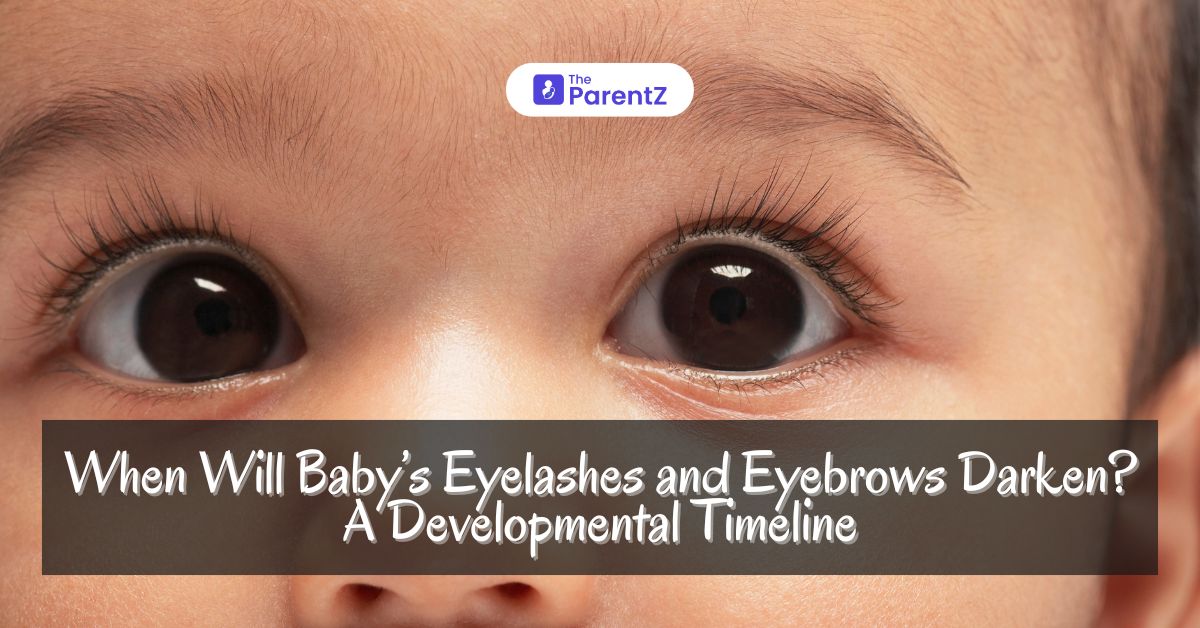The journey of watching a baby grow and develop is filled with many fascinating milestones, from their first smile to their first steps. Among these changes are the subtle yet intriguing developments in their physical appearance, such as the darkening of their eyelashes and eyebrows. Understanding when and how these changes occur can provide insight into your baby’s development. This article delves into the developmental timeline of when a baby’s eyelashes and eyebrows typically darken, the factors that influence this process, and what to expect during these changes.
The science behind it
On the head and face, the color of your baby’s hair hanging on the lashes or eyebrows is attributable to a pigment referred to as melanin. Melanin is produced by melanocytes, specialized cells that are in the hair follicles hormones, It characteristically depends on genetics, hormones, and sunlight for the production of the amount and type of melanin in a person. Basically, hair color becomes darker with increased production of melanin.
The babies are, however, born with a small amount of melanin in the hair bulbs of their follicles, and this is the reason a majority of them have very light or white hair at birth. melanin, As the age of the individual increases, the melanocytes contained in their follicles also become more active and thereby generate more melanin, thus causing a darker shade of hair color. Nonetheless, this transformation does not take place in a consistent or foreseeable way, with wide varieties in when and how significantly newborns’ hair turns.
Genetics: Many physiological traits are inherited by your baby from the parents and, to some extent, the grandparents and other ancestors.likely When two parents have dark hair, it is more likely that their baby will retain dark hair. Hair On the other hand, if one or both of the parents have blond hair or if there are any prevailing recessive genes for blond hair color in the family, the baby’s hair is likely to be lighter than automatically anticipated. In some other instances, the color of the baby’s hair may not even have any semblance to the parent but may resemble a relative who is distantly related to the parent or may resemble an ethnic background.
Hormones: Even the levels of hormones in your baby can influence the color of their hair, at least during the first months of their life. For instance, some infants may have higher levels of testosterone, which would in turn stimulate melanin production, leading to darker hair. that Conversely, some infants may have a lesser quantity of thyroid hormone, of which the letdown is conducive to melanin production, leading to a hair illusion that turns light.
Environment: Also, the sunlight that your baby gets can be another factor that impacts his hair color since UV can stimulate melanin secretion as well. Nonetheless, this is mostly an ephemeral and slight effect, as babies are overtly sensitive to the sun, and they should never be exposed to it for a prolonged period of time. color Other occurrences, which mainly come about due to the environment, pertaining to nutrition, stress, and sickness can also determine the color of the baby’s hair, though these are infrequent and trivial
The Developmental Timeline
Newborn Stage
At birth, a baby’s eyelashes and eyebrows may be light-colored and fine, especially if the baby has fair skin and light hair. This is completely normal and part of the natural development process. Some newborns might have more noticeable lashes and brows, while others have barely-there hair.
3-6 Months
During the first few months of life, babies experience rapid growth and many physical changes. Around 3-6 months, you may begin to notice that your baby’s eyelashes and eyebrows start to become more defined and possibly darker. This change is gradual and can vary greatly between babies.
6-12 Months
Between 6-12 months, many babies’ eyelashes and eyebrows will continue to darken and thicken. This period is marked by significant physical development, and changes in hair color and texture often become more noticeable. It’s common for parents to observe that their baby’s hair color, including eyelashes and eyebrows, starts to stabilize during this time.
Beyond One Year
After the first year, the darkening of eyelashes and eyebrows tends to slow down but can continue into toddlerhood. By this stage, most babies have established a more stable hair color, although changes can still occur as they grow older. For some children, the final color and thickness of their hair might not be fully apparent until they are a few years old.
Common Variations and Concerns
It’s important to remember that each baby is unique, and there is a wide range of normal when it comes to the development of eyelashes and eyebrows. Some common variations include:
- Sparse Hair: Some babies naturally have less hair, and their eyelashes and eyebrows may always be lighter or finer.
- Hair Loss: It’s common for newborns to lose some of their hair, including eyelashes and eyebrows, before it grows back thicker and darker.
- Uneven Growth: Eyelashes and eyebrows may not grow uniformly, leading to temporary asymmetry.
If you have concerns about your baby’s hair development, it’s always best to consult with a pediatrician for personalized advice.
Supporting Healthy Hair Development
While the color and texture of your baby’s hair are largely determined by genetics, you can support healthy hair development with these tips:
Gentle Cleansing
Tip: Use a mild, baby-specific shampoo to wash your baby’s hair. Avoid harsh chemicals that can irritate the scalp and hair follicles.
Moisturizing
Tip: Keep your baby’s scalp moisturized, especially if they have dry or sensitive skin. Use gentle, baby-safe moisturizers to prevent dryness and flakiness.
Proper Nutrition
Tip: Ensure your baby receives proper nutrition, as vitamins and minerals play a crucial role in healthy hair development. Breastfeeding or formula feeding provides essential nutrients, and as your baby transitions to solid foods, a balanced diet will continue to support overall health, including hair growth.
Avoiding Harsh Treatments
Tip: Avoid using adult hair products, heat styling tools, or tight hairstyles that can damage your baby’s delicate hair and scalp.
When to Consult a Pediatrician
While variations in hair development are typically normal, certain signs may warrant a consultation with a pediatrician:
- No Hair Growth: If your baby shows no signs of hair growth, including eyelashes and eyebrows, by six months, it’s advisable to seek medical advice.
- Patchy Hair Loss: Significant, unexplained patchy hair loss could indicate an underlying condition that needs attention.
- Skin Issues: Red, inflamed, or scaly skin around the eyebrows and eyelashes should be evaluated by a healthcare provider.
Conclusion
Watching your baby’s eyelashes and eyebrows develop and darken is a delightful part of their growth journey. While there is a general timeline for these changes, each baby is unique, and variations are normal. By understanding the factors that influence hair color and supporting healthy hair development, you can ensure your baby’s hair grows in healthy and strong. If you have any concerns about your baby’s hair growth or overall development, don’t hesitate to consult your pediatrician for guidance and reassurance








Be the first one to comment on this story.